#Maurya Empire
Explore tagged Tumblr posts
Photo

Territories "conquered by the Dharma" according to Emperor Ashoka
98 notes
·
View notes
Text
The Yaudheya - who, what? They were an ancient military people based in the Eastern Regions of the Sapta Sindhu - a copper coin of theirs here depicting the Hindu War God Kartikeya (who is also a war god under other names via Buddhism spreading his story Eastward most commonly as Skanda, and in China, as Wei Tuo -- Skanda serves as a celestial guardian role here).


The word Yaudheya comes from Brahmi script (a script you'll see two iterations of/nods to in Tales of Tremaine by name).
Their name comes from the word Yodha - which means warrior/s. And this is backed up by their resistance of invasions by the Kushan Empire, and the Indo-Scythians. The Yaudheya would eventually claim dominion over all the Kuru Kingdoms held and then they themselves would become later absorbed into the Maurya Empire by Chandragupta Maurya. Eventually, the Indo Greek Kingdom Yavana would capture a majority of this empire, but fail to subdue to Yaudheya, who would successfully triumph until eventually losing to to the Indo Scythian Rudradaman I.
But the Yaudheya left an impression on the ruler that led to the inscription of a Sanskrit in prose (not poetry) honoring them as proud heroes - it is known as the Junagadh rock inscription of Rudradaman - dated at 150 CE (common era)
#Yaudheya#ancient military#Sapta Sindhu#Kartikeya#Buddhism#Skanda#Wei Tuo#Brahmi#Tales of Tremaine#Yodha#Kushan Empire#Kuru Kingdoms#Maurya Empire#Chandragupta Maurya#Yavana#Sanskrit#Rudradaman#ancient history#little known history#who and what#learn something new#this is interesting#ancient people#ancient world#world history#southeast asia#Asian history#Indo Greek#indo european
2 notes
·
View notes
Text
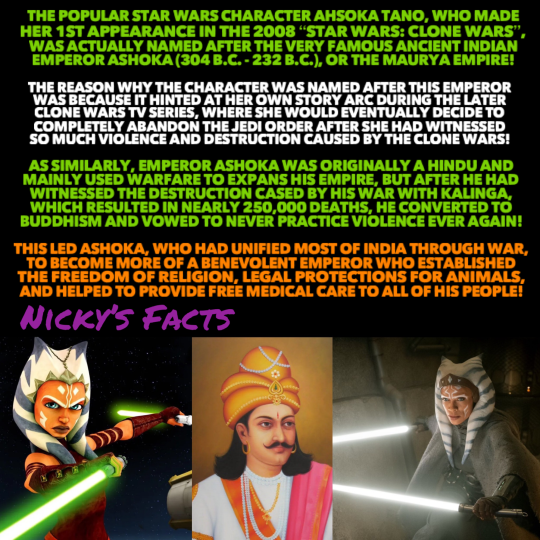
A long time ago two Ashokas went on a quest for moral redemption, changing their worlds forever!
🧡🇮🇳🤍
#history#ashoka tano#star wars#ashoka the great#emperor#indian history#star wars the clone wars#may 4th#maurya empire#kalinga war#movie history#female characters#jedi#hinduism#buddhism#ancient history#girl power#clone wars series#role model#women of star wars#historical figures#india#royalty#ancient#nickys facts
5 notes
·
View notes
Text
Flag of Buddhist India

This is the flag of Buddhist India. It comes from a world where Buddhism remained the dominate religion of India. It began during the reign of Ashoka the Great. As in our world, Ashoka converted to Buddhism after spending much of his life as a warlord who united much of India. Unlike our world, however, Ashoka formalized the relationship between the Sangha and the secular government. Ashoka’s system can be thought of as similar to the role the Catholic Church played in Medieval Europe in our world. Buddhist monasteries received funding via taxes, and the monks often involved themselves in the affairs of the state. Another result of Ashoka’s reforms was that the Maurya Empire lasted several centuries longer than it did in our world. The empire covered almost all of the Indian Subcontinent, and its continued existence lead to a sense of Pan-Indian identity. In fact, the Maurya Empire would come to hold the same cultural significance in India as the Roman Empire does in the West, and the Han Dynasty does in China. All future Indian empires would, to varying degrees, attempt to emulate the glories of the Maurya Empire. The changes resulting from Ashoka’s reforms ultimately meant that Vedantic Hinduism never came to be. However, life for the average Indian didn’t really change all that much under Buddhism. Most people continued to worship the same local gods they always had. The old traditions mixed freely with the new. For example, you might go to the Buddhist temple to pray for enlightenment and contemplate philosophy. However, if your child got sick, you would pray to whoever the local healer deity happened to be. The caste system never came to be, but there was a still a strict social hierarchy within Indian society. In time, several Buddhist monks began to study the natural world, and developed natural philosophy of a sort. This led to several discoveries and innovation, the most significant of which was the discovery of gunpowder. India went on several campaigns of expansion. Several of these were nominally to spread Buddhism, but in practice, were really about expanding India’s political and cultural power. India conquered Persia, and even managed to push as far west as Egypt and the Levant. However, holding these lands proved harder. The empire shrank to only the Indian Subcontinent in a little over 100 years. However, this brief period of expansion did lead to Buddhism spreading further. Iran follows a combination of Zoroastrianism and Buddhism, and Central Asia is majority Buddhist. Southeast Asia is also majority Buddhist. It also helps that Islam was never found in this world. Buddhist remain a significant minority in the Near East. Unfortunately, there have also been numerous conflicts between Buddhists and Christians in these lands. Buddhism never made major in-roads in Europe, barring a few minor communities in the Balkans. There were some Buddhist communities in Spain and Southern France, but they were whipped-out by Christian forces. Unlike our world, most Westerners do not stereotype Buddhists as being pacifists. In fact, due to a misunderstanding about Buddhist belief in reincarnation, many Christians stereotyped Buddhists as being violent, and having an incredibly cavalier attitude towards human life. However, during this world’s equivalent of the Enlightenment, several European scholars began to re-examine and reevaluate Buddhism. Though, they also often viewed it through a heavily Orientalist lens. The flag is orange and maroon in reference to the colors of Buddhist monk robes. The white is to offset the orange and maroon. The Wheel of Samsara, also known as the Wheel of Rebirth, is displayed prominently in the center of the flag.
Link to the original flag on my blog: https://drakoniandgriffalco.blogspot.com/2023/05/flag-of-buddhist-india.html?m=1
#alternate history#Flags#Flag#Buddhist India#Flag of Buddhist India#Buddhism India#Buddhism#India#vexillology#alternate history flags#alternate history flag#Ashoka the Great#Maurya Empire#Mauryan Empire#alt history
13 notes
·
View notes
Text
बिन्दुसार ने चाणक्य को क्यों निकाला : मौर्यवंश का दूसरा एपीसोड
KKN लाइव के इस विशेष सेगमेंट में, कौशलेन्द्र झा मौर्यवंश के दूसरे शासक बिन्दुसार की चर्चा कर रहे हैं। बिन्दुसार, चंद्रगुप्त मौर्य के पुत्र थे और उन्होंने 29 वर्षों तक मगध पर शासन किया। इस एपिसोड में बिन्दुसार के शासनकाल, उनके पिता चंद्रगुप्त और आचार्य चाणक्य के साथ उनके संबंधों पर विशेष ध्यान दिया गया है। यह वीडियो उन विवादों को भी उजागर करता है, जिनकी वजह से आचार्य चाणक्य ने मौर्य दरबार छोड़…
0 notes
Text

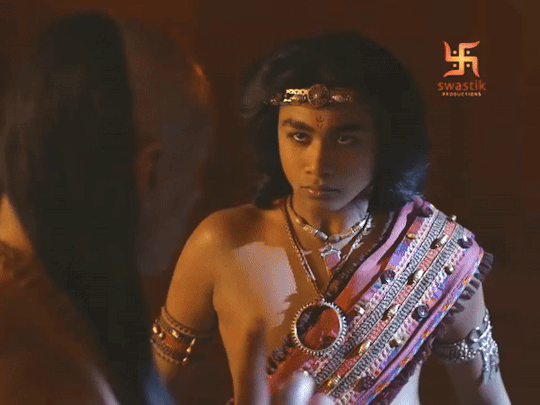

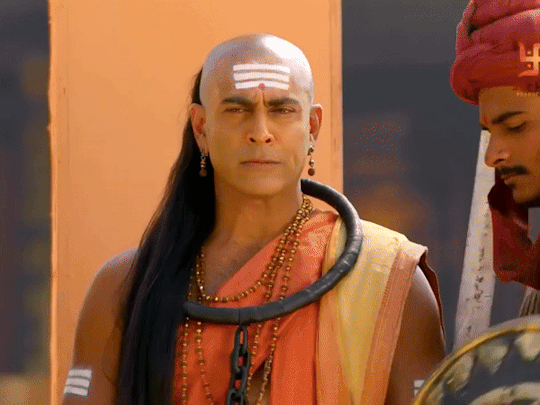
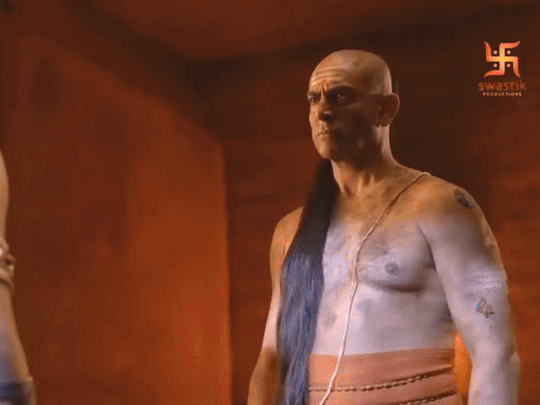
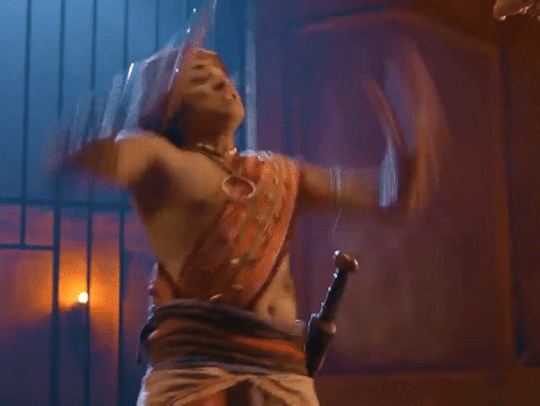
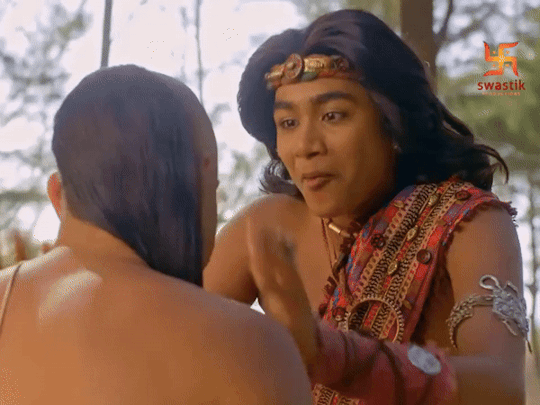

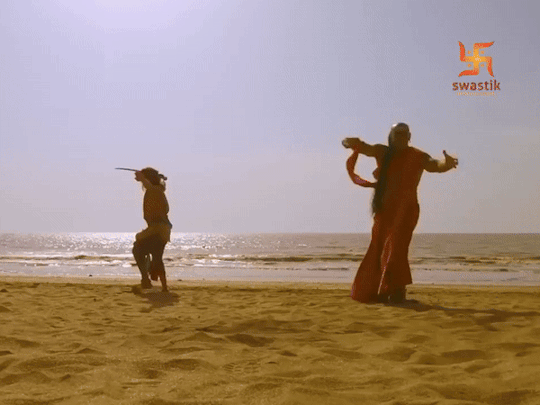


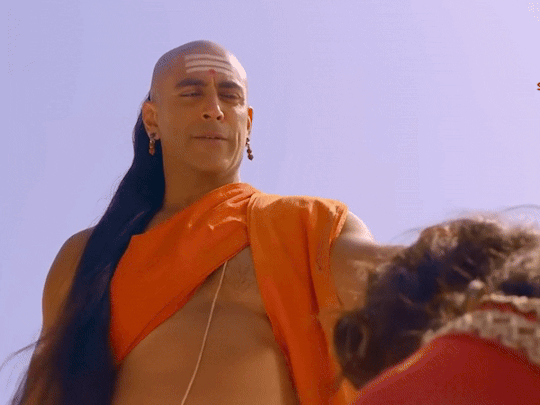
Name a more iconic duo... I'll wait
#yes this is a chandragupta maurya post#you have no idea how much i love these two#this show is my roman empire#there's only one person in this fandom and that is me#chandragupta maurya#tarun khanna#kartikey malviya#indian tumblr#desiblr#desi tumblr#gifset
11 notes
·
View notes
Text
how well our textbooks have convinced us that Asoka was indeed great.
he spent his early life establishing autocracy through violence. but then, our books tell us that he changed after the War of Kalinga and started spreading peace and the notions of Buddhism. he started sending messengers to popularise Buddhism amongst other states.
but isn't emphasising on one particular religion and trying to make everyone follow it, a form of autocracy too?
so, didn't Ashoka start with violent autocracy and end with peaceful autocracy, trying to be powerful all through?

source: india's ancient past, rs sharma
#ashoka#history#ashoka the great#india#indian history#buddhism#king#ruler#mauryas#chandragupta#chanakya#Empire
1 note
·
View note
Text
Magadha Empire | The kingdom of Magadha
Magadha Empire | The kingdom of Magadha Magadha Empire | The kingdom of Magadha Magadha Was The Most Powerful Mahajanapada Among The Sixteen Mahajanapadas Of BC. Means To Know The History Of Maurya Dynasty (A) Indica By The Greek Ambassador Megasthenes (B) Economics Of Kautilya (C) Ashoka’s Inscriptions (D) Buddhist Texts Deepvansh And Mahavansh (E) Mudrarakshas Natak Of…
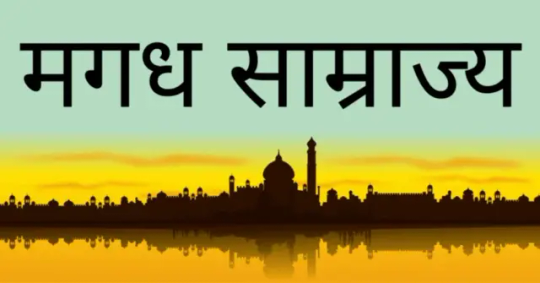
View On WordPress
0 notes
Text
roy also plays up his outrage at casteism among sikhs, muslims, etc much more than he himself does in the speech. in fact, he actively downplays it, which makes sense given that they pose an awkward problem for final his analysis and proposed solution to the caste problem (respectively: hindu dogma and a casteless state religion). taking after the example of the buddha and guru nanak seems less inspiring as a call to action in the fight against caste when you remember the two of them failed to uproot it too!
read amebedkars the annihilation of caste, plus arundhati roys book-length historical preface. in honesty i prolly learned more from the latter, which is more than anything a screed against the cult of gandhi as mahatma, tho she does give the impression of a writer willing to selectively present historical facts to paint a narrative. still, its facts shes painting with, and in many cases its very hard to imagine any context that could exonerate gandhi from the relevant charges. certainly a helpful pov to finally read in depth rather than as offhand iconoclastic remarks
the speech itself i think left me more flummoxed. ambedkar is at his best when he is railing against the evils of the caste system and the implausibility of various defences and concessions made on its behalf. this is a pretty easy pitch for me tho, growing up as a westerner without any reason to be invested in the chatuvarna. its like the cagot, such an obviously perverse system from an external vantage point that it hardly seems fair to award credit for thoroughly denouncing it unless youve been raised to see it as natural. still, its very stirring as a bit of skewering, especially of the "moderate" and "reformist" casteist positions it attacks, and of the "caste-blind" socialists and liberals who ignore the internal divisions and acrimony the caste system imposes on their envisioned base
he is more compelling as a symptomatologist than as a diagnostician or prescriber/prognostician. he takes by the end what seems like a maximally anti-"materialist" view of the causes of the persistence of the caste hierarchy: the social phenomenon of caste is due entirely to vedic dogmatism, to the point that advocating social rather than doctrinal reforms (primarily: inter-dining and inter-marriage) is futile and self-defeating. this is the context for his remarks about the need to reject the authority of the shastras. this interpretation of the basis of caste discrimination is accompanied by a shocking proposed solution: a purified and democratised hinduism as a state religion, whose new priesthood and scripture/dogma are to be administered by the state itself. only thus can the plague of casteism be stamped out effectively at the root (retrograde religious beliefs)
the blow of what reads to my own usamerican sensitivities as a brand of revolutionary theocracy and state control of religion is somewhat softened by his apparent lack of ambition in implementing it. he is upfront that he thinks the kinds of anti-caste reform he is advocating are simply impossible in the face of hindu society, a demoralisation bolstered in part by a top-down view of social change on which it is only possible as guided by a societys intellectual class—which he identifies with the class least incentivised to upend the system: the brahmins. obviously i had seen ppl draw the analogy between usamerican antiblack racism and indian dalit suppression, but it had never occurred to me that the topic would invite the obvious caste analogue of afropessimism
on the topic of ambedkars predictions about the future of hindu society, its sort of interesting to place him in the context of the current ascendancy of hindutva on the subcontinent. where ive seen ppl (roy in the preface included) speak of modi and ambedkar in the same breath, its usually (when not simply whitewashing ambedkar) been to take him on board as an ally against the hindutva menace. but im not sure how well the text of the annihilation of caste supports that reading? not in terms of what ambedkar would think of modi and hindutva, ofc; its not at all hard to imagine which side he would come down on there. but at the core of much of his criticism of the caste system is its inflexibility and incompatibility with a modern, cohesive, mobilised nation state and nation-building project. a house divided against itself etc etc. on his view, the system introduced social resentments and hostilities too deep to permit a hindu identity that could effectively unite the national public. one is inclined to say: would that it were so!
anyway these are just rough first thoughts, its very much not a topic where ik a huge amount. still wanted to put them on paper for an audiencxe, just to help clarify them to myself more than anything
108 notes
·
View notes
Text
Boita Bandana, a cultural tribute to ancient maritime activities
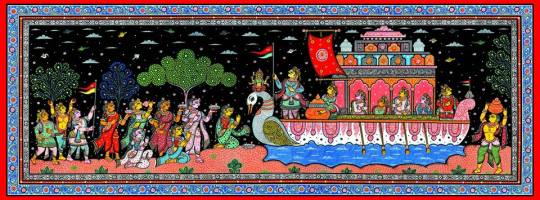
People in Odisha celebrate Boita Bandana, a boat festival marking the region's maritime glory. This annual observance occurs on Kartik Purnima, the full moon day in the holy month of Kartik. Boita Bandana is a cultural tribute to Odisha’s ancient maritime activities and trade relations with Southeast Asian countries.
Symbolic Act of Floating Boats:

The most important ritual of Boita Bandana is floating little hand-made boats. They are usually made of plantain or banana stems and other similar natural and traditional materials. Boats are laden with various offerings such as flowers, coins, ‘Kaudis’ or cowries, ‘Pana’ or betel leaves, ‘Guā’ or betel nuts, and a lighted lamp. This symbolic act pays homage to Odisha’s rich maritime history and the courageous sailors who engaged in trade with Southeast Asian nations. The festival serves as a cultural bridge connecting the present generation with the seafaring legacy of their ancestors.
Remembering the Sadhabas:
Boita Bandana echoes the collective consciousness & memories of the past. It commemorates the legacies of the Kalinga Sadhabas – the maritime merchants & seafarers. The origins of this festival descend from an ancient maritime tradition of merchant trade and voyages across the ocean to different regions of Asia, which was well developed in this region known in ancient times as Kalinga. This ancient maritime tradition is preserved through this festival which celebrates the voyages of their ancestors, to Southeast Asian countries, which include mainly present-day Bali, Java, Sumatra, and Borneo in Indonesia, Malaysia, Sri Lanka, Thailand, Cambodia, and all the way to Champa region in Vietnam. Local traditions ascribe the origins of the ritual tradition to around the 3rd century BC as Kalinga was a well-known powerful maritime power with strong trading links across the oceans, especially during the reign of the Maurya empire whose rulers coveted the region for its influence.
Kartika Purnima was considered auspicious for them to begin their voyage. It was during this time of the month as well when the Northeast monsoon winds started blowing from November, which was favorable for the merchant mariners as the winds would guide the sails of their boats across the ocean leading them southwards towards Sri Lanka. Thereafter using the ocean currents to cross the Indian Ocean to reach Southeast Asia where they would carry on sailing across different regions for trade. After trading the ships would take the ocean countercurrent to get back to Sri Lanka in time to take advantage of the Southwest monsoon around May and return home. Hence the families of the traveling sailors used to perform rituals on the day of Kartik Purnima for their safe journey and return, which henceforth became the tradition of Boita Bandana (Worship of the Boats).
Boita Bandana and Jagannath Culture:
At Sri Mandira (Jagannath Puri), the deities wear a variety of attires, or ‘besa’, throughout the year. During the holy month of Kartika, they receive special ‘besa’ outfits. In years when the Kartika month includes six days of ‘Panchaka’ instead of the usual five, the deities wear the rare and unique ‘Nagarjuna Besa’. In this special attire, the deities are dressed like ‘Nagarjuna’, a revered figure. This unique ‘besa’ is a significant part of the Kartika Purnima celebrations in Puri. And, Boita Bandana is every year meant to be celebrated in the early morning of Kartik Purnima.
Boita Bandana serves as a vibrant reminder of Odisha’s historical ties with other maritime civilizations and instills a sense of cultural pride among the people.
Information from different sources.
33 notes
·
View notes
Photo

Chandragupta's Empire, 4th century.
by LegendesCarto
65 notes
·
View notes
Photo

Shishunaga Dynasty
The Shishunaga Dynasty (also Sishunaga/Shaishunaga Dynasty) ruled the Magadha Kingdom in ancient India from c. 413 BCE to c. 345 BCE (in some sources from 421 BCE). It is said to be the third imperial dynasty of Magadha after the Brihadratha and the Haryanka, though the Brihadratha Dynasty is considered as mythical now. The first ruler of the dynasty was Shishunaga himself after whom it has been named, who came to power when the people revolted against the earlier Haryanka Dynasty in the 5th century BCE. The Shishunaga Dynasty had a very short reign before it was succeeded by the Nandas and then the Mauryas, but it too contributed to the solid foundation of the Magadhan Empire which was to dominate the Indian subcontinent for the upcoming centuries.
India Before the Shishunagas
After the Vedic civilization took its roots in the Indian subcontinent from around 1500 BCE, various political units rose in northern and northwestern India. This changed from the 6th century BCE onwards when some kingdoms rose to the east in the fertile Indo-Gangetic plains. During this time, the Indian subcontinent formed mainly into two political units – the Janapadas (which roughly means foothold of the common people) and the Mahajanapadas (the greater foothold of the people). There were 16 Mahajanapadas, and in the 6th century BCE, four out of them became very powerful – Kosala, Avanti, Vatsa, and finally Magadha. The ancient kingdom of Kosala falls roughly to some parts of the present-day Uttar Pradesh state in India. Avanti was Central India and now the states of Madhya Pradesh and Chhattisgarh, and Vatsa was also another part of modern Uttar Pradesh state.
The most powerful of them was Magadha, which would go on to dominate the entire subcontinent during the time of the Mauryas. All the polities close to Magadha except Avanti were defeated in battle and gradually annexed by the warrior king of Ajatashatru (r. c. 493/492 BCE - c. 462/460 BCE) of the Haryanka Dynasty. He also defeated the powerful confederation of the Vrijjis to the immediate north with their capital at Vaishali after 16 years of ancient Indian warfare from c. 484 BCE to c. 468 BCE. By the time Shishunaga ascended to the throne, Magadha, roughly corresponding to the present-day provinces of Bihar, Jharkhand, Uttar Pradesh, Odisha, West Bengal, and the countries of Bangladesh and Nepal, had a very effective system of administration and government, a powerful army and a flourishing trade network.
Continue reading...
40 notes
·
View notes
Text
Religious Imageries in JJK: The Conflicting Views of Shinto and Buddhism.
Disclaimer: This is not an explanation post, this is an observer post. I will try to sum up what I have observed so far.
Let's begin with the definition and history of both Shinto and Buddhism.
Shinto [神道]: Combined with the kanji of God/Kami (神) and Road /Michi(道), Shinto literally means The way of the God(s). It is the indigenous religion of Japan and is as old as Japan itself.
Shinto belief is polytheist and animistic as it has almost 8 million gods that are derived from nature and natural things. This religion revolves around "Kami". Kami can be manifested from anything, but the most important Kami are the natural ones.
Sun, Rain, Earth etc. The most important central Kami is Amaterasu the Kami of the Sun. The exact history of Shinto is untraceable but it was mentioned in the Yayoi Period (300 BCE to 300 CE) of text.
Shinto describes the world as a inhabitant of the human and the kami they worship. It describes the world as founded by the kami and once humans/ living beings pass away they become kami as well.
It is safe to say that Shinto belief described humanity as living being as a whole, where even after death they don't living. The idea of morality or immorality is also absent from it. The existence of Kami is the manifestation of humanity itself and not separated from human beings.
Fun Fact: Chinese indigenous religion 'Dao' has the same characters as Shinto's kanji. So it might be possible that Shinto actually comes from Chinese Daoism.
Buddhism: Buddhism is an Indian religion. It revolves around the teaching of Buddha. Buddha is no myth. Even though convoluted, early texts gives his name as "Gautama" and he lived around 5th to 6th Century BCE.
In India his name is mostly known as "Siddharth". He was born in Lumbini in present day Nepal and grew up in Kapilavastu. The border of India and Nepal, a town of the Ganges plain of present day Bihar and Uttar Pradesh.
The most notable person who helped spread Buddhism around India so much that it was spread in the NEA and SEA is Emperor Asoka (304-232 BCE) from the Maurya Empire (322-180 BCE).
Buddhism circles around the suffering of human, the circle of life and Karma (deed). Where a soul is constant as it is being born in this world as human, it goes through the cycle of life (suffering) and it dies.
It also talks about Dharma as the ultimate truths, also that humans are born to fulfill a certain role. Moksha: The liberation from the earthly desire which should be the ultimate goal of a human being.
It also draws the line between God and humans as Gods are separated from the earthly matters and pushes the idea of Gods creating the universe and the creating the humanity.
The Mix of both Religion:
Though the idea of Shinto and Buddhism is pretty contradicting it existed with each other for centuries.
Even though Buddhism entered in japan in Yayoi Period (250-538 AD), it became popular in Asuka Period (538-710) due to buddhist sect taking the rein of the country. Initially Buddhism and Shinto coexisted and even mixed with each other. It was called Shinbutsu-Shougou. However, later it was forcefully separated by Japanese nationalists in Meiji Era (1868-1912) and Shinto became the state religion of Japan with the Emperor being worshipped as Kami the descendants of Amaterasu.
Cursed Spirit: The reason I am writing this is not because the obvious depiction of buddha, Buddhist shrines and mention of clans and sects etc. What caught my interest was that the idea of "Cursed Spirit".
The textbook explanation of Cursed Spirit is that the reaction of human emotions but as we see it is actually the manifestation of human existence. As long as humans will exist, curses will also exist.
Which pretty much resembles the idea of Kami.
The timeline: The golden era of jujutsu was Heian Era which historically existed between 794-1185 AD. Almost a century after Buddhism was introduced in Japan. Also in that era Sukuna rose up as the king of curses. Which may indicate the clans existed even before and Sukuna existed throughout.
Characters like Kenjaku and Tengen their birth and living timeline are unknown but they might just as be as old as Japan, like Shinto.
Getou and Megumi are the only two people who can control curses as Shikigami. Which is another japanese Shinto belief that has also been associated with "Curses" during Heian Era.
The people who used to control Shikigami were called Onmyoji (Yin-Yang Master).
Both of them were either antagonised or villfied by the jujutsu society at one point.
Also the most important part that made me think about this is...Sukuna's domain.

This resembles an average Shinto shrine...

The Tori is missing.
Insanity.
Anyways. I am not saying that Gege is making one religion look bad and another look good. It's not true and actually far from it. Though contradiction, Gege shows the good and bad of both sides. Kenjaku is bad and the higher ups are as worse as him.
Personally I think this is a battle of belief of the world with a main character emerges with no beliefs at all. Itadori Yuuji hates Sukuna but not by the virtue of being Gojo's student but his own opinion about him. In the latest chapter he says "Human beings are not a tool, so nobody's existence is premediated." Which contradicts the idea of "Dharma".
The message might be "If you want to change the world, you have to diverge from the existing path and forge your own."
24 notes
·
View notes
Text
On the topic of fantasy pet peeves, or rather fantasy criticism pet peeves, I see a lot of people make a big deal about "lazy worldbuilding" when a kingdom shares the name of either its ruling dynasty. This isn't exclusively a charge levied against media of East Asian origin, but it certainly shows up there a lot.
Now this was very unusual in medieval Europe. Most European countries are derived from tribal names: the Franks became France, the Danes became Denmark, the Angles became England, the Poles became Poland, et cetera. (Though often with a fair bit of migration.) Many others come from their provincial designations under the rule of larger states: Roman Hispania became España; Habsburg-era "pays d'embas", "lands down there", was translated literally into Dutch as Nederlanden.
Pre-medieval kingdoms - most notably the Merovingian and Carolingian Empires - were referred to by their ruling dynasties, but this came to a pretty significant end because of the Germanic tradition of partitive succession. Lands were divided between the heirs instead of passed to a singular successor, leading to a single dynasty ruling multiple different realms - most notably for Carolingians, who in two generations went from controlling most of Western Europe as a unified Frankish Empire to five kingdoms who were often at war with each other.
Needless to say, the rule of several hostile kingdoms by the same nominal dynasty quickly put the kibosh on any sense of dynastic naming in Europe, and tribal names came to dominate as things were formalised in the medieval period. Not so for much of the rest of the world. (Or Liechtenstein.)
Almost every major Arab state took its name from the ruling dynasty, which spread to many non-Arab Muslim realms such as the Ottoman Empire (named for the ruling House of Osman, also called the Ottomans), the Ghaznavid Empire (ruled by the Ghaznavid dynasty), the Timurid Empire (ruled by, surprising no one, the Timurid dynasty)...
Likewise, China is pretty much exclusively described historically in terms of its dynasties, who traditionally picked a new name for their state and government when they came to power. While there was a general idea of a territorial "China" (Chinese Zhongguo, often translated as "Middle Kingdom"), it was only rarely used compared to the dynastic titles. (As far as I'm aware, only the Qing ever really used it in an official context to refer to themselves, and even then the official name was still "(Great) Qing".)
Indian historiography is a bit split; the Maurya and Gupta Empires are referred to by their dynasty, but also as dynasties of a territorial/tribal Magadha Kingdom. The Pala Empire is solely named for its dynasty, but was the successor state of the Gauda Kingdom, named for its territory.
The Aztecs were primarily defined in terms of their city-states, but the Mayans were split between city names and dynastic ones at the time of the Spanish invasion. (Or at least they seem to be; it's hard to find good sources on the etymology of Mayan principalities in English.)
(I'd put in a note about the Incan Empire as well; "Inca" in Quechua essentially means "king" or "nobleman", so a literal English interpretation of "Incan Empire" would be "Emperor's Empire". The endonym for the Incan Empire translates to something like "union of four provinces", with two of the provinces being ethnonyms and two being directional. One of the directional ones might be both, and it's unclear which came first. Honestly, you could do another post about this just for directional names...)
So yes, "King X of the Kingdom of X" is a completely normal thing. Hell, we have two countries that do it today - Liechtenstein (ruled by the House of Liechtenstein) and Saudi Arabia (ruled by the House of Saud). (Both of them are absolute monarchies.)
20 notes
·
View notes
Text
Ancient India and China - Vocabulary
Vedas -- a collection of hymns, chants, ritual instruction, and other religious teachings
Brahman -- a single spiritual power beyond the gods and existing in all things
Moksha -- union with Brahman
Karma -- action and result
Dharma -- personal religious and moral duties
Ahimsa -- nonviolence to all people and things
Siddhartha Gautama -- a Hindu prince -- seeked causes of human suffering
Eightfold Path -- right aspirations -- directs people in achieving moral life goals and enlightenment
Nirvana -- union with the universe
Chandragupta Maurya -- founded the first Indian empire
Asoka -- Chandragupta's grandson
Dowry -- payment to the bridegroom
Shang -- China's first dynasty
Clans -- groups of families -- share a common ancestor
Mandate of Heaven -- divine right to rule
Dynastic Circle -- rise and fall of dynasties
Feudalism -- where lords govern their own land but owed military support to a leader
Zhou Dynasty -- dynasty that established feudalism
Philosophy -- system of ideas
Confucius -- philosopher -- concerned with social order and good government
Laozi -- philosopher -- founded Daoism
Shi Huangdi -- "first emperor"
Qin Government -- Shi Huangdi's government
Hanfeizi -- philosopher -- inspired legalism
Expansionism -- policy of increasing territory
.
Patreon
#studyblr#notes#history#historyblr#world history#world history notes#ancient india#ancient china#philosophy#history of philosophy#world history vocab#history vocab#history vocabulary#vocab list#vocabulary list#historical governments#civilization#hanfeizi#shi huangdi#confucius#laozi#zhou dynasty#shang#dynastic circle
9 notes
·
View notes
Text

Chandragupta Maurya, the founder of the Maurya Empire in ancient India, is said to have had a group of female bodyguards known as the "Virangana" or "brave women." It's believed that he chose female warriors as bodyguards because he considered them to be loyal, skilled in combat, and less likely to be influenced by political agendas or power struggles within his court. Additionally, having female bodyguards may have also served a symbolic or propaganda purpose, showcasing the strength and capability of women in his empire.
12 notes
·
View notes